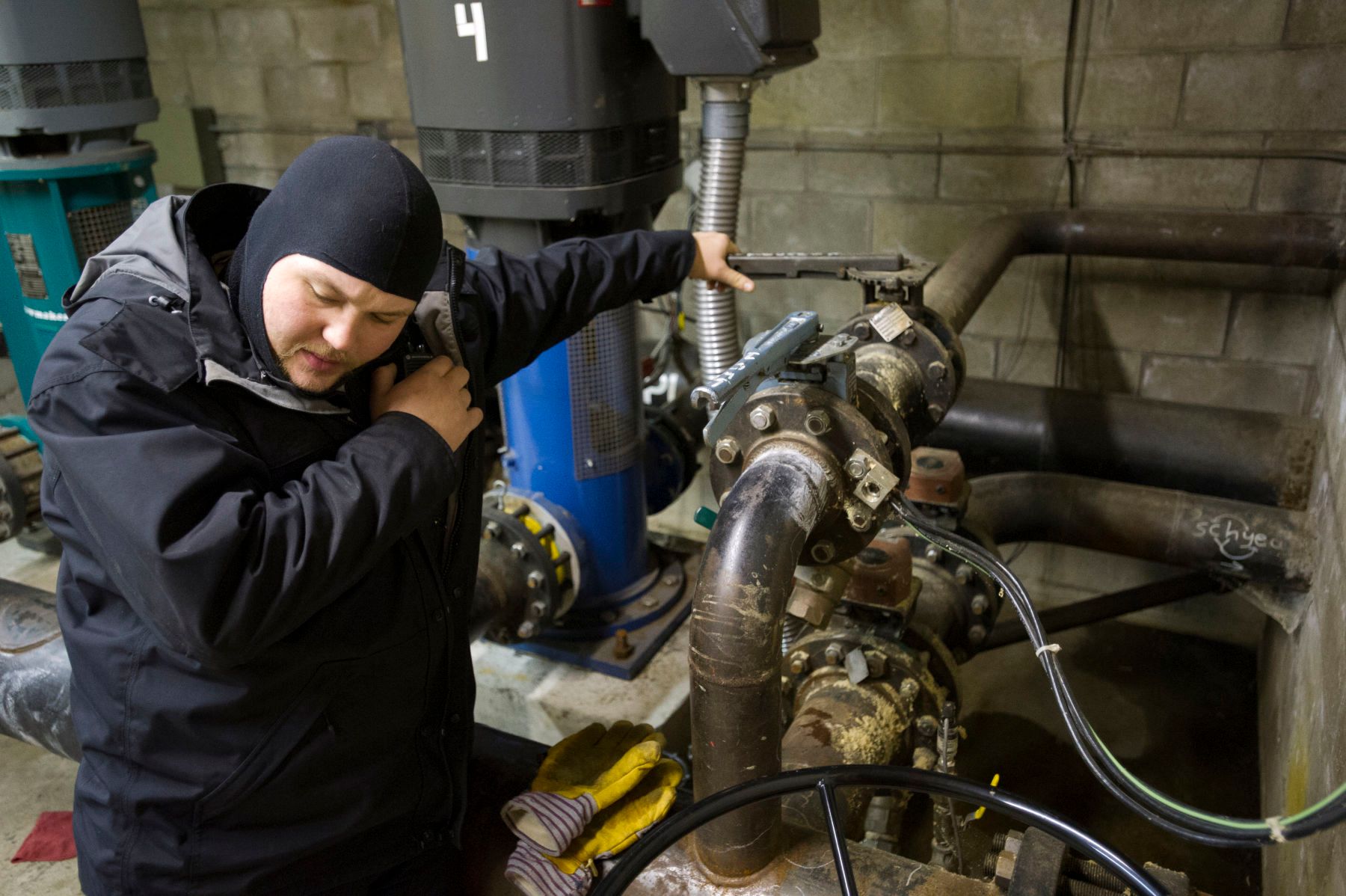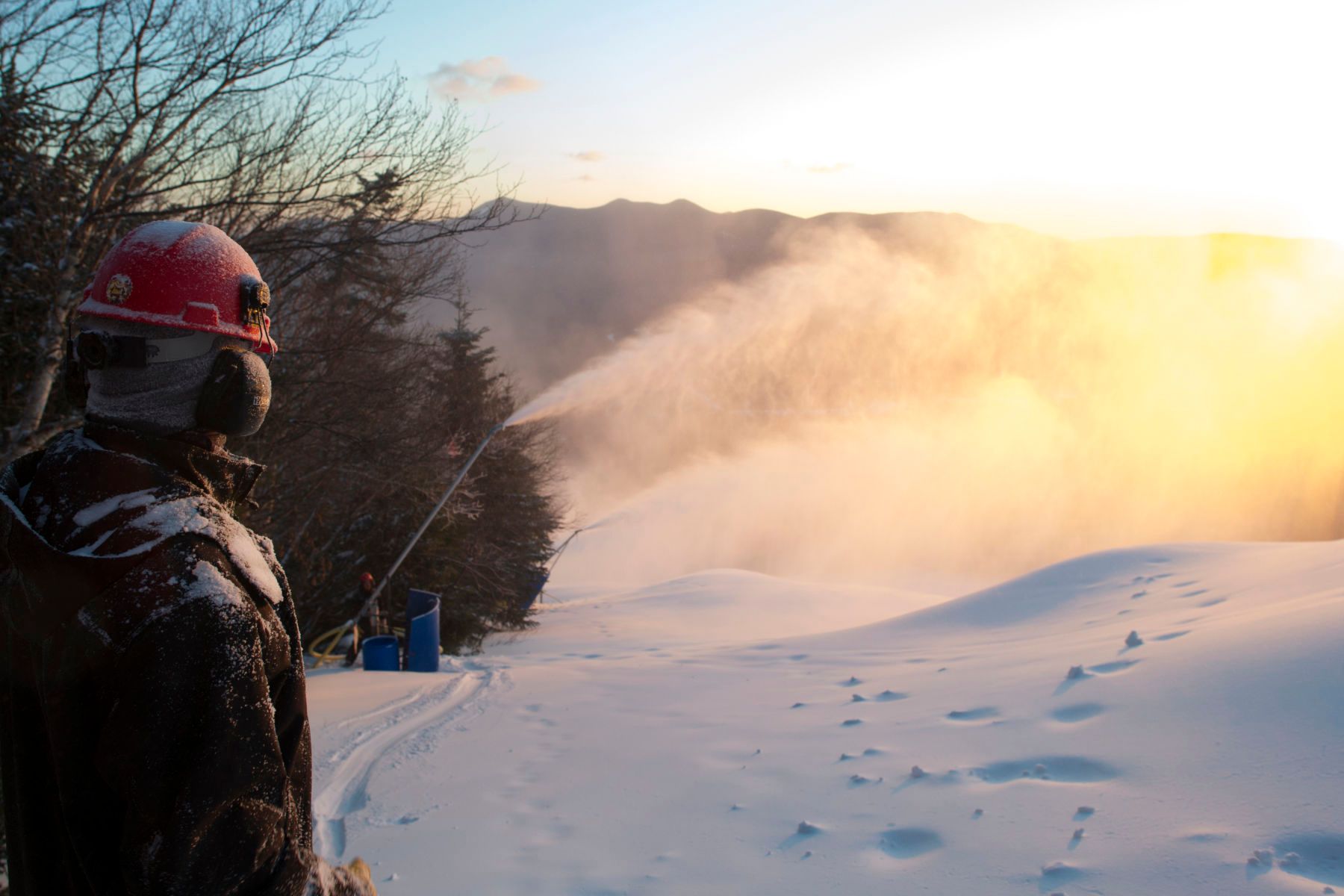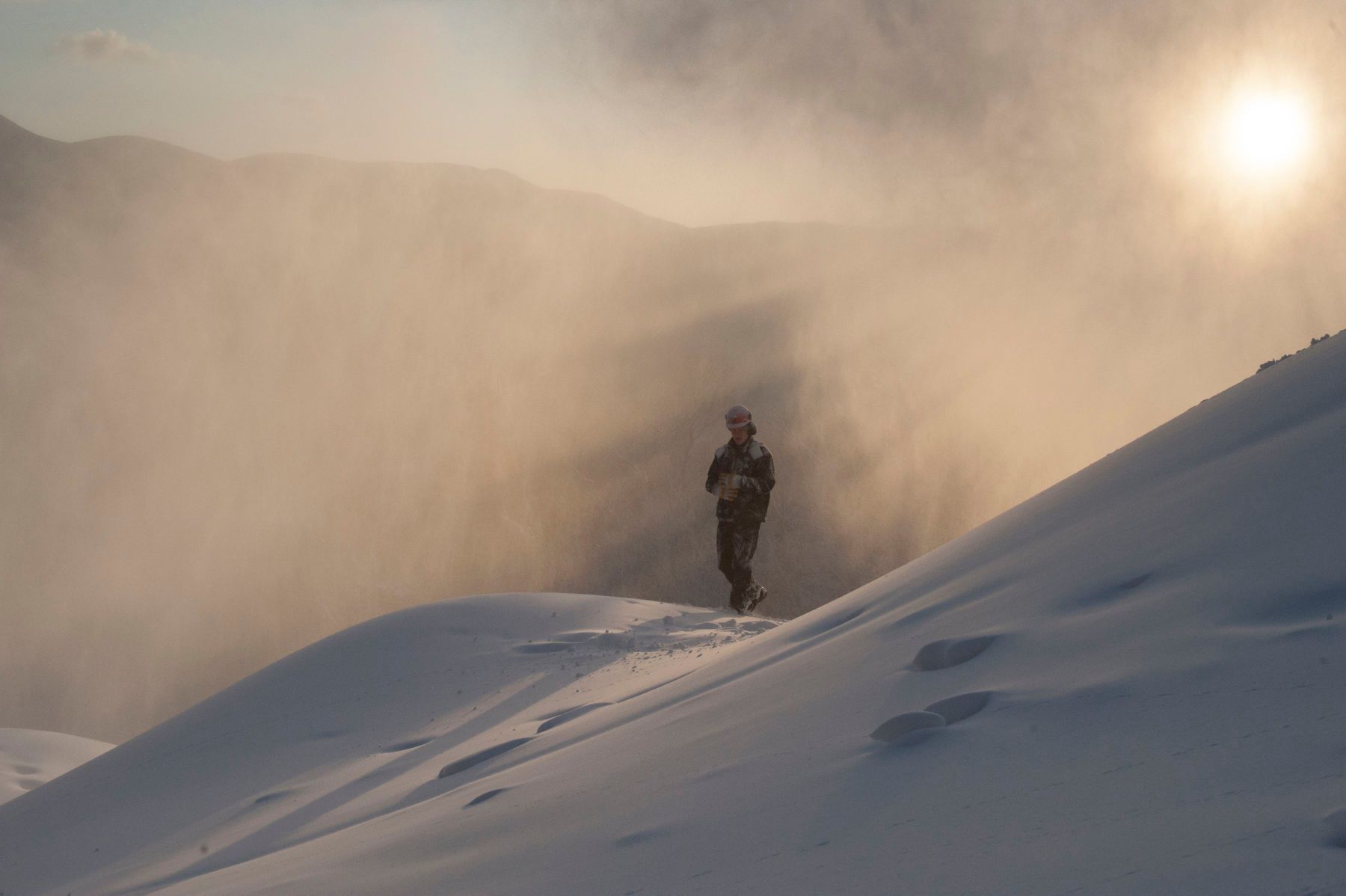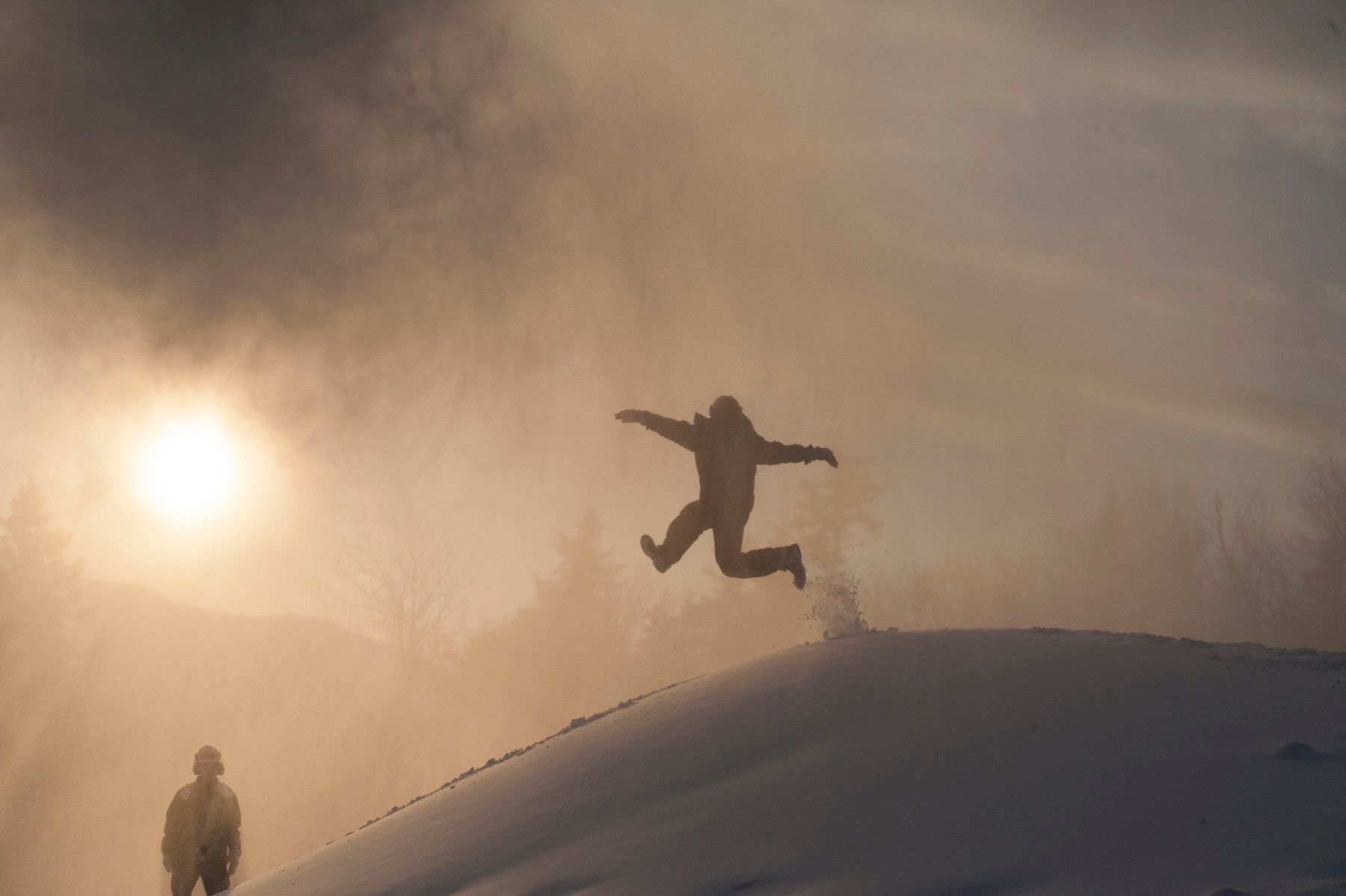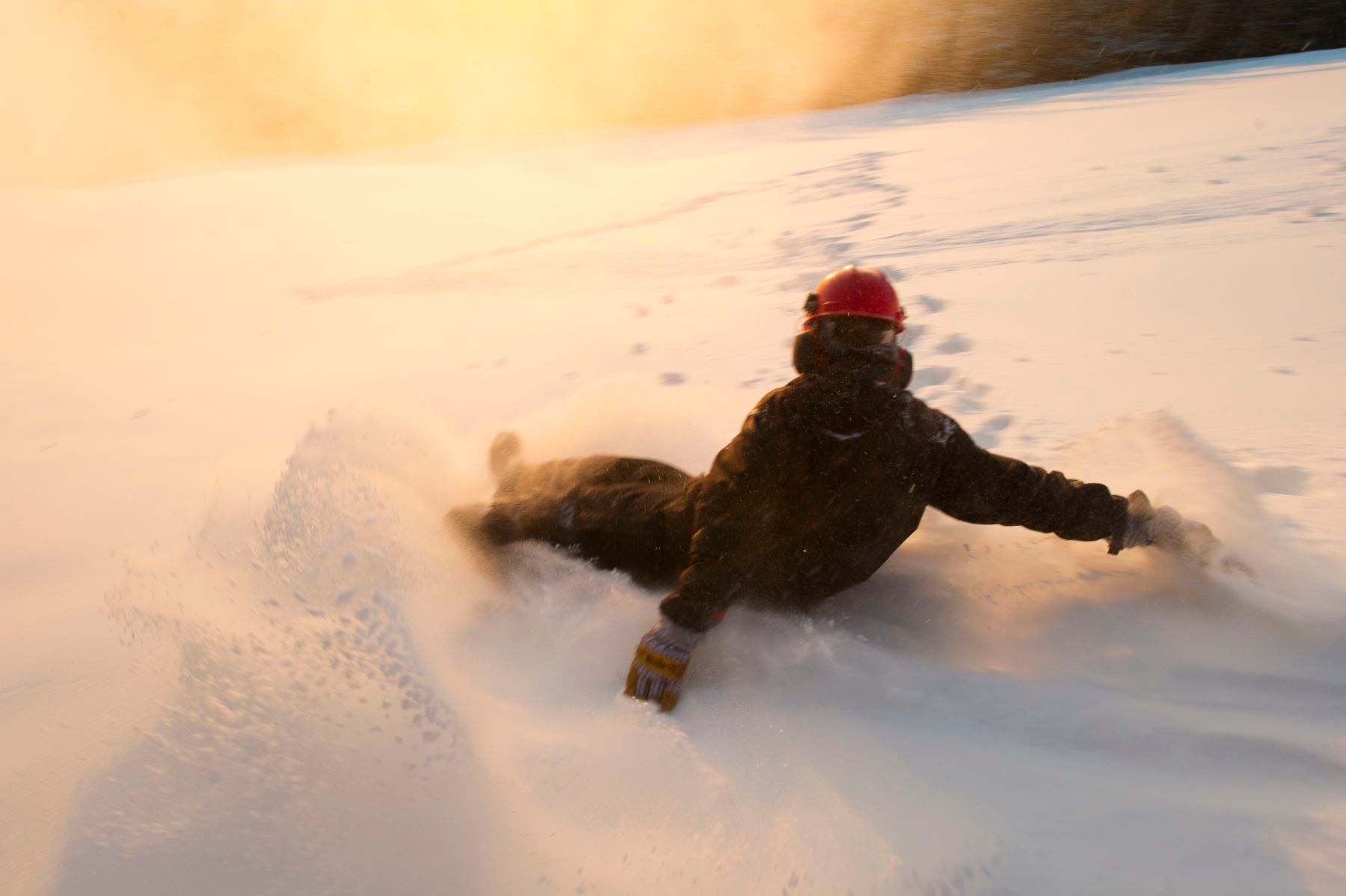-

Near the base of the mountain the snowmakers finished up their first gun run of the night. At 3am the two had been up on the mountain for 2 hours.
-

As the ball dropped in New York City ringing in 2015 the snowmaking crew at Waterville Valley had little time to celebrate. An accident earlier in the night led the day crew to shut down operations. Noah Crane tightened up his boots as others prepared to head up onto the mountain.
-

Night Crew Foreman, Ben Oakley (r) read's the operation report from the previous shift as the rest of the crew suited up before heading up the mountain.
-

The crew headed to the hose barn to load hoses and snow guns onto to a snow cat before heading up the mountain. Snowmaking equipment is kept at the base of the mountain behind their headquarters.
-

Still waking up at the begining of their 12 hour shift the men slowly loaded 16 snow guns and 40 hoses into the snow cat to move up the mountain.
-

As the Snow Cat trudged higher up the mountain one of the men braced himself from the spindriff.
-
![After starting a gun one of the men went over to inspect the flow and quality of snow being blown. 1gjv_83222334]()
After starting a gun one of the men went over to inspect the flow and quality of snow being blown.
-
![Often times snowmakers encounter ice, which is an unfortunate bi-product and tends to cover everything. If all the ice isn't cleared from the valves the hose won't properly seal creating a dangerous situation when turning on snow guns. In the past hoses have blown out of the valves, striking snowmakers. 1gjv_8789]()
Often times snowmakers encounter ice, which is an unfortunate bi-product and tends to cover everything. If all the ice isn't cleared from the valves the hose won't properly seal creating a dangerous situation when turning on snow guns. In the past hoses have blown out of the valves, striking snowmakers.
-
![Up on the mountain the crew rode in the back of the snow cat, tossing hose and snow guns out the back on a trail they were preparing to make snow on. 1gjv_8519]()
Up on the mountain the crew rode in the back of the snow cat, tossing hose and snow guns out the back on a trail they were preparing to make snow on.
-
![Foreman, Ben Oakley uses a radio to communicate with the base office in pushing air and water down a specific trail. The noise in the pumphouse is deafening, with extremely pressurized air and water hissing through the pipes. 1pump]()
Foreman, Ben Oakley uses a radio to communicate with the base office in pushing air and water down a specific trail. The noise in the pumphouse is deafening, with extremely pressurized air and water hissing through the pipes.
-
![One of the men using a portable propane torch to thaw out a frozen valve up on the mountain. Large pipes are used to bring air and water up the entirity of the mountain. Though impressive the crew often finds itself battling the elements and pipes, constantly fixing blown valves are frozen sections. 1gjv_8597]()
One of the men using a portable propane torch to thaw out a frozen valve up on the mountain. Large pipes are used to bring air and water up the entirity of the mountain. Though impressive the crew often finds itself battling the elements and pipes, constantly fixing blown valves are frozen sections.
-
![The pumphouse, a small, bunker looking building sits halfway up the mountain. It offers the only protection from the elements on the mountain at night and is the staging point for opening air and water lines throughout the mountain. 1gjv_8324]()
The pumphouse, a small, bunker looking building sits halfway up the mountain. It offers the only protection from the elements on the mountain at night and is the staging point for opening air and water lines throughout the mountain.
-
![Inspecting snow after turning up a gun. 1gjv_8869]()
Inspecting snow after turning up a gun.
-
![Before heading down the trail to turn on snow guns the men talked with crew Foreman, Ben Oakley about which trails they would open. 1gjv_8703]()
Before heading down the trail to turn on snow guns the men talked with crew Foreman, Ben Oakley about which trails they would open.
-
![Around 1am, an hour after the ball dropped ringing in 2015, Waterville Valley snowmaker, Adam Glover was high up on the mountain for his first gun run; turning snow guns on down Upper Bobbies, one of the mountains more popular trails. 1gjv_9420]()
Around 1am, an hour after the ball dropped ringing in 2015, Waterville Valley snowmaker, Adam Glover was high up on the mountain for his first gun run; turning snow guns on down Upper Bobbies, one of the mountains more popular trails.
-
![Fire hoses are used to distribute pressured air and water to the snow guns. Waterville Valley, like many East Coast Ski Mountains runs snowmaking crews 24/7 when the weather allows it, with two twelve hour shifts. 1newshzzz]()
Fire hoses are used to distribute pressured air and water to the snow guns. Waterville Valley, like many East Coast Ski Mountains runs snowmaking crews 24/7 when the weather allows it, with two twelve hour shifts.
-
![Snow guns blasted snow onto trails high up on the mountain. 1gjv_9124]()
Snow guns blasted snow onto trails high up on the mountain.
-
![A snowmaker cleared ice from a snow gun as he headed down the mountain. As well as setting up and turning on the guns, snowmakers make trips up the mountain to maintain the guns and check the snow being made. 1chumppump]()
A snowmaker cleared ice from a snow gun as he headed down the mountain. As well as setting up and turning on the guns, snowmakers make trips up the mountain to maintain the guns and check the snow being made.
-
![After starting one of the guns a snowmaking walked out to check the snow. The snowmakers change the mixture of water and air depending on temperatures to keep the guns producing even snow. 1gjv_8927]()
After starting one of the guns a snowmaking walked out to check the snow. The snowmakers change the mixture of water and air depending on temperatures to keep the guns producing even snow.
-
![If the water mixture is too high the snow will come out wet, covering trails with slush and ice. 1snowglare]()
If the water mixture is too high the snow will come out wet, covering trails with slush and ice.
-
![1gjv_8928]()
-
![A snowmaker turned on a gun after connecting hoses to the air and water valves. 1gjv_8737]()
A snowmaker turned on a gun after connecting hoses to the air and water valves.
-
![A snowmaker used his sleeve to check the quality of snow coming out of a gun. Watching the snow fall can help the snowmaker decide whether the snow is too wet or dry. 1gjv_8981]()
A snowmaker used his sleeve to check the quality of snow coming out of a gun. Watching the snow fall can help the snowmaker decide whether the snow is too wet or dry.
-
![With only a headlamp to see a snowmaker slides down the mountain to the next gun. Many snowmakers use this technique, dubbed, the butt slide to get down the mountain quickly. 1gjv_8994]()
With only a headlamp to see a snowmaker slides down the mountain to the next gun. Many snowmakers use this technique, dubbed, the butt slide to get down the mountain quickly.
-
![Snowmakers cleared hoses of ice and check snow quality as they headed down the mountain. 1gjv_9076]()
Snowmakers cleared hoses of ice and check snow quality as they headed down the mountain.
-
![A snowmaker paused mid gun run to take it all in. 1squint]()
A snowmaker paused mid gun run to take it all in.
-
![1gjv_9077]()
-
![1gjv_9083]()
-
![1gjv_9207]()
-
![With little downtime the crew stakes hoses and snow guns in preperation for heading back up the mountain. 1gjv_9212]()
With little downtime the crew stakes hoses and snow guns in preperation for heading back up the mountain.
-
![1gjv_9607]()
-
![With the sun rising two of the men from the snowmaking crew were dropped off at the top of the mountain to inspect a section snow guns that had been running for over 3 hours. 1gjv_9231]()
With the sun rising two of the men from the snowmaking crew were dropped off at the top of the mountain to inspect a section snow guns that had been running for over 3 hours.
-
![1gjv_9336]()
-
![1gjv_9309]()
-
![A snowmaker "butt slide" down the mountain with the sun rising over the mountains in front of him. 1gjv_9260]()
A snowmaker "butt slide" down the mountain with the sun rising over the mountains in front of him.
-
![Wind often hampers snowmaking efforts, blowing snow off course, into the woods 1gjv_9332]()
Wind often hampers snowmaking efforts, blowing snow off course, into the woods
-
![A snowmaker inspected the snow conditions. 1gjv_9514]()
A snowmaker inspected the snow conditions.
-
!["Butt sliding" down the slopes is an effective tool the snowmakers use to commute down the trails. With a couple of steps and a leap you can slide down large sections of the trails. 1gjv_9523]()
"Butt sliding" down the slopes is an effective tool the snowmakers use to commute down the trails. With a couple of steps and a leap you can slide down large sections of the trails.
-
![1gjv_9356]()
-
![A snowmaker took advantage of some downtime at the pumphouse to catch a quick nap towards the tail end of a 12 hour shift. 1gjv_9659]()
A snowmaker took advantage of some downtime at the pumphouse to catch a quick nap towards the tail end of a 12 hour shift.
-
![A snowmaker looked down at the first skiers of the morning as he rode a chairlift to the top of the mountain to begin another gun run 1gjv_832223224]()
A snowmaker looked down at the first skiers of the morning as he rode a chairlift to the top of the mountain to begin another gun run
-
![When the mountain is open the snowmakers use the chairlifts to get around the mountain. 1gjv_9597]()
When the mountain is open the snowmakers use the chairlifts to get around the mountain.
-
![Near the end of the shift the crew worked together to inspect the remaining trails. 1gjv_9879]()
Near the end of the shift the crew worked together to inspect the remaining trails.
-
![Each shift has 5-8 crew members who work the trails in pairs to maintain the snow guns. 1gjv_9952]()
Each shift has 5-8 crew members who work the trails in pairs to maintain the snow guns.
-
![1gjv_9716]()
-
![When butt sliding on groomed trails snowmakers can reach considerable speeds, passing skiers and snowboarders on occasion. 1gjv_9675]()
When butt sliding on groomed trails snowmakers can reach considerable speeds, passing skiers and snowboarders on occasion.
-
![1gjv_9693]()
-
![Two of the crew reposition a gun with the water still running. Snowmakers wear gor-tex pants and jackets but they are often no match to the amount of water the encounter throughout their shift. 1gjv_9741]()
Two of the crew reposition a gun with the water still running. Snowmakers wear gor-tex pants and jackets but they are often no match to the amount of water the encounter throughout their shift.
-
![1gjv_9760]()
-
![The job is both physical and dangerous, with many snowmakers slipping on ice or in worse case senarios, crashing snow mobiles. Frozen, pressurized hoses have often broken off, whipping violently past heads of snowmakers as well. 1gjv_9762]()
The job is both physical and dangerous, with many snowmakers slipping on ice or in worse case senarios, crashing snow mobiles. Frozen, pressurized hoses have often broken off, whipping violently past heads of snowmakers as well.
-
![1gjv_9720]()
-
![When the snow is blowing too wet and winds are whipping in the wrong direction, snow can back fire, burying guns and hoses with heavy, wet snow. If the hoses are buried for too long they can freeze. 1gjv_9983]()
When the snow is blowing too wet and winds are whipping in the wrong direction, snow can back fire, burying guns and hoses with heavy, wet snow. If the hoses are buried for too long they can freeze.
-
![Snowmakers clearing a frozen gun near the end of their shift. Frozen guns are often the most dangerous situations to encounter with clogged, pressurized hoses waiting to shoot in any direction. 1gjv_9963]()
Snowmakers clearing a frozen gun near the end of their shift. Frozen guns are often the most dangerous situations to encounter with clogged, pressurized hoses waiting to shoot in any direction.
-
![1gjv_9956]()
-
![1gjv_9826]()
-
![Snowmakers passed skiers at the end of their shift around 11:30am. With the weather predicted to be in the low teens throughout the week the men would change clothes, head home, sleep and prepare for more grueling hours up on the mountain. 1gjv_9571]()
Snowmakers passed skiers at the end of their shift around 11:30am. With the weather predicted to be in the low teens throughout the week the men would change clothes, head home, sleep and prepare for more grueling hours up on the mountain.



